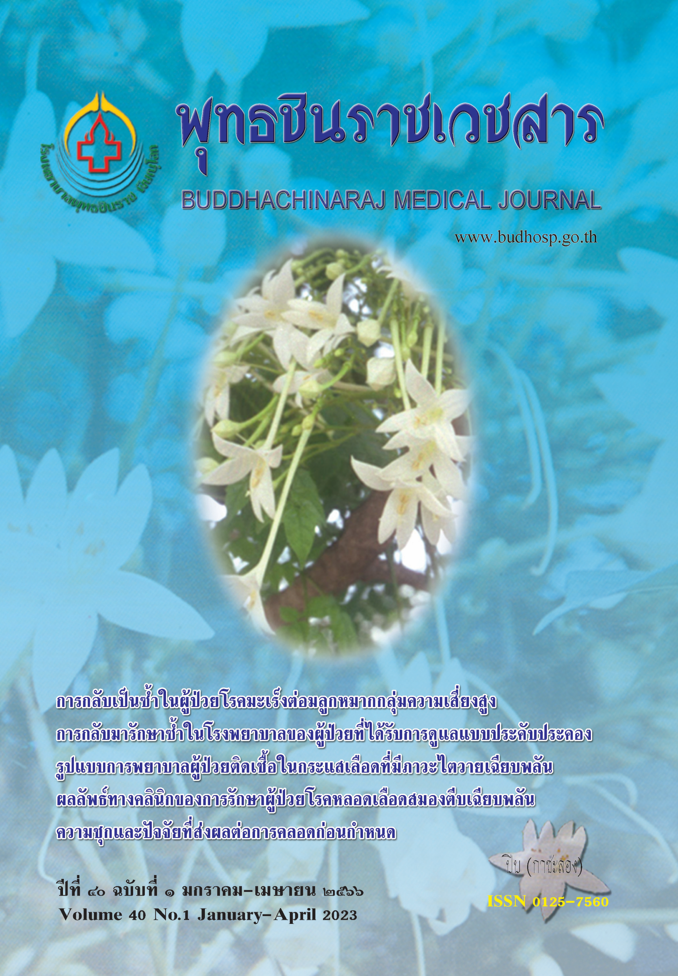ผลลัพธ์ทางคลินิกของการรักษาผู้ป่วยโรคหลอดเลือดสมองตีบเฉียบพลัน ด้วยยาละลายลิ่มเลือด Recombinant Tissue Plasminogen Activator ทางหลอดเลือดดำ
ผลลัพธ์ทางคลินิกของการรักษาผู้ป่วยโรคหลอดเลือดสมองตีบเฉียบพลัน
คำสำคัญ:
โรคหลอดเลือดสมองตีบเฉียบพลัน, ยาละลายลิ่มเลือดทางหลอดเลือดดำ, ผลลัพธ์ทางคลินิกบทคัดย่อ
การรักษาผู้ป่วยโรคหลอดสมองตีบเฉียบพลัน (AIS) ด้วยยาละลายลิ่ม เลือด recombinant tissue plasminogen activator (rt-PA) ทาง หลอดเลือดดำเป็นวิธีรักษามาตรฐาน การศึกษาข้อมูลผู้ป่วยย้อนหลัง จากเวชระเบียนแล้วเก็บข้อมูลใหม่ไปข้างหน้าครั้งนี้มีวัตถุประสงค์เพื่อ เปรียบเทียบผลลัพธ์ทางคลินิกระหว่างการได้รับและไม่ได้รับยา rt-PA ในผู้ป่วย AIS ที่มารับการรักษา ณ หอผู้ป่วยโรคหลอดเลือดสมอง โรง พยาบาลสมเด็จพระเจ้าตากสินมหาราชระหว่างวันที่ 1 มกราคม พ.ศ. 2560 ถึงวันที่ 31 ธันวาคม พ.ศ. 2564 พบผู้ป่วย AIS ทั้งหมด 1,635 ราย เป็นเพศชาย 901 ราย มีอายุเฉลี่ย 65 ปี ประสิทธิผลที่ 24 ชั่วโมงใน กลุ่มที่ได้รับยา rt-PA มีคะแนนประเมินทางระบบประสาท NIHSS ลดลง มากกว่า 4 คะแนนมากกว่ากลุ่มที่ไม่ได้รับยา rt-PA อย่างมีนัยสำคัญ ทางสถิติ [ร้อยละ 48 และร้อยละ 12 ตามลำดับ (p < 0.001)] และ ณ 3 เดือน หลังเกิดโรคพบว่าผู้ป่วยกลุ่มที่ได้รับยา rt-PA สามารถดำรงชีวิต ได้อย่างอิสระมากกว่า กลุ่มที่ไม่ได้รับยาอย่างมีนัยสำคัญทางสถิติ [ร้อย ละ 70 และร้อยละ 39 ตามลำดับ (p < 0.001)] ส่วนด้านความปลอดภัย
พบผู้เสียชีวิตที่ 3 เดือนทั้ง 2 กลุ่มในสัดส่วนที่ใกล้เคียงกัน (ร้อยละ 3.8 และร้อยละ 4.3) กลุ่มที่ได้รับยา rt-PA พบการเกิดเลือดออกในสมอง มากกว่ากลุ่มที่ไม่ได้รับยาอย่างมีนัยสำคัญทางสถิติ [ร้อยละ 6 และร้อย ละ 0.6 ตามลำดับ (p < 0.001)] สัดส่วนภาวะเลือดออกในสมองที่มี อาการทั้ง 2 กลุ่มไม่แตกต่างกัน สรุปได้ว่าการรักษาผู้ป่วย AIS ด้วยการ ฉีดยาละลายลิ่มเลือด rt-PA เข้าหลอดเลือดดำภายใน 4.5 ชั่วโมงหลัง เกิดอาการเป็นวิธีรักษาที่มีประสิทธิผลและปลอดภัย
เอกสารอ้างอิง
Prasat Neurological Institute. Clinical Practice Guideline for ischemic stroke. Bangkok, Thailand: Prasat Neurological Institute; 2019.
Demaerschalk BM, Kleindorfer DO, Adeoye OM, Demchuk AM, Fugate JE, Grotta JC, et al. Scientific rationale for the inclusion and exclusion criteria for intravenous Alteplase in acute ischemic stroke: a statement for healthcare professionals from the American Heart Association/American Stroke Association. Stroke 2016;47(2):581–641.
Emberson J, Lees KR, Lyden P, Blackwell L, Albers G, Bluhmki E, et al. Effect of treatment delay, age, and stroke severity on the effects of intravenous thrombolysis with Alteplase for acute ischaemic stroke: a meta-analysis of individual patient data from randomised trials. Lancet Lond Engl 2014;384(9958):1929–35.
Muchada M, Rodriguez-Luna D, Pagola J, Flores A, Sanjuan E, Meler P, et al. Impact of time to treatment on tissue-type plasminogen activator–induced recanalization in acute ischemic stroke. Stroke 2014;45(9):2734–8.
Jintaganon T. The effectiveness and safety of thrombolysis with recombinant tissue-type plasminogen activator for acute ischemic stroke. J Prapokklao Hosp Clin Med Educat Center 2019;36(3):227-35.
Biose IJ, Oremosu J, Bhatnagar S, Bix GJ. Promising cerebral blood flow enhancers in acute ischemic stroke. Transl Stroke Res [Internet]. 2022 Nov 17 [cited 2023 Feb 6]; Available from: https://doi.org/10.1007/s12975-022-01100-w
วิทยาลัยแพทย์ฉุกเฉินแห่งประเทศไทย. แนวทางการรักษาและให้ยาละลายลิ่มเลือดสำหรับโรคหลอดเลือดสมองเฉียบพลันภายนอกโรงพยาบาลและห้องฉุกเฉิน ปี 2563. [Internet]. 2022 Nov 17 [cited 2023 Feb 6]; Available from: https://drive.google.com/file/d/1qBLX_RtKKqsp0r6_mtG8bhHX5UzJyAWA/view?fbclid=IwAR3v830eVWm-zt6m8I9aAAM4NQFN97A9IsqgFjWjKh7SmA52M1wWcoXW_D4
Bruno A, Close B, Switzer JA, Hess DC, Gross H, Nichols FT, et al. Simplified modified Rankin Scale questionnaire correlates with stroke severity. Clin Rehabil 2013;27(8):724–7.
Hoffman H. What is The NIH Stroke Scale (NIHSS)? Saebo [Internet]. 2017 [cited 2023 Feb 6]. Available from: https://www.saebo.com/blog/nih-stroke-scale-nihss/
Bill O, Zufferey P, Faouzi M, Michel P. Severe stroke: patient profile and predictors of favorable outcome. J Thromb Haemost 2013;11(1):92–9.
Nisar T, Hanumanthu R, Khandelwal P. Symptomatic intracerebral hemorrhage after intravenous thrombolysis: predictive factors and validation of prediction models. J Stroke Cerebrovasc Dis 2019;28(11):104360.
Siegler JE, Boehme AK, Kumar AD, Gillette MA, Albright KC, Martin-Schild S. What Change in the National Institutes of Health Stroke Scale should define neurologic deterioration in acute ischemic stroke?. J Stroke Cerebrovasc Dis 2013;22(5):675–82.
Mehrpour M, Afrakhte M, Shojaei SF, Sohrabi A, Ashayeri R, Esmaeili S, et al. Factors predicting the outcome of intravenous thrombolysis in stroke patients before rt-PA administration. Casp J Intern Med 2019;10(4):424–30.
Lyden P. Using the National Institutes of Health Stroke Scale: a cautionary tale. Stroke 2017;48(2):513–9.
Watcharasaksilp K. The outcome of thrombolytic therapy for acute ischemic stroke after extended treatment from 3 to 4.5 hours in Maharaj Nakorn Chiang Mai Hospital. Chiang Mai Med J 2015;54(2):71–80.
ดาวน์โหลด
เผยแพร่แล้ว
ฉบับ
ประเภทบทความ
สัญญาอนุญาต
ลิขสิทธิ์ (c) 2023 ``โรงพยาบาลพุทธชินราช พิษณุโลก

อนุญาตภายใต้เงื่อนไข Creative Commons Attribution-NonCommercial-NoDerivatives 4.0 International License.






